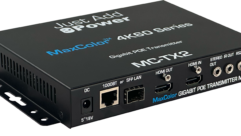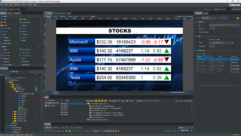Cedia 2006: A Show In Transition
This year’s show was full of aggressively priced, plug-and-play HDTV products ? not the usual CEDIA Expo fare.
Pete Putman
I FIRST ATTENDED CEDIA Expo back in 1997, when the show was held in Atlanta and attracted about 12,000 attendees. In those days, it was a pretty exclusive show, loaded with high-end audio and video equipment. Everything was a custom install, and there were plenty of big bucks attached to those installs.
This year’s show couldn’t have been more different, and in fact, felt more like InfoComm. The aisles were loaded with HDTVs with jaw-dropping low prices. LCD and plasma HDTVs with screen sizes of up to 65 inches were just part of the story, as were a plethora of 1920×1080 front projectors for much less than $6,000.
In fact, there were numerous CEDIA exhibitors that sell their products primarily through distribution or only big box stores rather than through custom installers. JVC, Sony, Panasonic, Sharp, LG, Samsung, Epson, InFocus, Toshiba, Mitsubishi, Hitachi — I could go on and on, but all had big CES-style booths full of big box store HDTVs, blue laser players, and accessories.
My fellow analysts and I fully expected to see an abundance of 1920×1080 projectors, rear-projection TVs, and flat panels at the show. What we didn’t expect to see was the aggressive pricing, such as a 42-inch 1080p integrated LCD HDTV for $2,495 (from Sharp) or a 1080p front LCD projector for $4,495 (from Mitsubishi). And those were just two examples.
By my count, there were at least half a dozen 1080p LCoS and LCD home theater projectors out for inspection, and all had target prices of less than $6,000. Mitsubishi’s HC5000 took the low-price honors, but Sony’s VPL-VW50 1080p LCoS model wasn’t priced much higher. Epson, Panasonic, Cinetron, JVC, and BenQ all demonstrated 1080p projectors, and while no firm prices were quoted, they all pointed to that magic sub-$6,000 figure (in reality, closer to $4,999).
Sony and Sharp both showed 52-inch LCD flat-panel HDTVs, with Sharp’s SRP at $4,800 and Sony’s at about $6,500. Current 32-inch LCD panels are now available for less than $1,600, while 37-inch models are retailing for less than $2,000. Even 46-inch/47-inch 1080p LCD HDTVs are dropping below $3,500, with some products hitting the $2,999 price point.
How about microdisplay rear projection HDTVs? Prices ranged as low as $2,800 (MSRP) for 52-inch 1080p models to $3,099 for 56-inch sets, $3,800 for 61-inch models, and $6,000 for 73-inch versions.
I think you see the point here. CEDIA Expo isn’t really a custom design and installation show anymore. Rather, it resembles a small, low-key CES or InfoComm show, with many low-priced, plug-and-play products out for inspection.
Granted, there still are plenty of higher-priced display products from traditional CEDIA channel companies, such as Runco/Vidikron, SIM2, projectiondesign, DreamWorks, and Fujitsu. But not all of these are manufacturers, and some of them are OEMing the same products being hawked at much lower prices for the brick-and-mortar-store channels.
A good example is Fujitsu, which owned 50 percent of a joint venture in plasma manufacturing with Hitachi until a couple of years ago. The company has since reduced its stake to less than 20 percent, and is now a re-brander.
At the show, Fujitsu’s new Aviamo line of high-end LCD and plasma HDTVs carried substantial price premiums over the same big box store products, such as an integrated 37-inch LCD HDTV for $6,999 (compared to $2,000), a 50-inch plasma set for more than $10,000 (which sells for less than $3,000 at Best Buy), and a 65-inch plasma for $20,000 (a Panasonic product that will sell for $10,000 in mainstream stores).
So what’s in store for the future of the CEDIA market? Will it continue to grow? Will it eventually go away? It’s hard to say, but with electronics manufacturers everywhere adopting mass market distribution models — out of necessity — it will certainly increase pressure on small, custom systems integrators.
And I believe it’s fallacious reasoning to think that a company can live indefinitely and exclusively off the high end of the home theater market, which is apparently a belief still held dearly by more than one exhibitor at the show. Not only that, more and more home theater customers are web-savvy. They know full well what projectors and HDTVs are selling for these days.
And what about big box stores’ push into home theater design and integration? Some time ago, Best Buy bought out the Magnolia home theater chain, and is currently in the midst of a nationwide remodeling effort to expand the Magnolia custom install program. Its success with the Geek Squad venture has now led the company to go after custom home theater installs.
Circuit City has also recently announced a similar program with its Firedog initiative — field support and installation of both PC-centric and home theater products.
With the proliferation of low-cost projectors and flat-screen HDTV sets on the market, both companies obviously smell an opportunity.
Granted, the long-time CEDIA home theater systems integrator has much more experience than either company right now. But if a potential customer spends his time cruising the aisles of Best Buy, how will he ever find out about the value of the integrator’s services, or that integrator’s various CEDIA certifications?
Another wild card is the emergence of small regional home theater integration franchises, such as Theater Extreme. This company, which currently has 20 showrooms and more on the way, delivers complete theaters from $3,000 to $12,000. These modular designs take advantage of the low prices for home theater projectors and displays, and combine them with other economies of scale in control circuits, audio components, and screens that only a distributor can offer.
The result is literally a home theater in a box, although the box is much larger than the one you’d find at Costco or Sam’s Club. But the bill of materials is pre-determined. All customers have to do is pick out some color and wall treatment options (which can even be done over the Internet), and they’re off to the races.
Theater Extreme makes no attempt to hide the fact that it’s targeting the small custom home theater design and integration shops. In a recent letter to shareholders, company President Scott Oglum said: “…Our true competitors are the small sellers of custom home systems. Against them, we believe that we already have an advantage of size and economies of scale…unlike others in this highly fragmented market, we are able to buy many private-label products directly from manufacturers in China rather than having to use lower-margin and higher priced name-brand items. By blending our private labels with brand names, customers get a total solution at a reasonable price.”
Only time will tell whether Theater Extreme or similar concepts will succeed. But it already has one crucial part of the equation solved — having enough critical mass to deal direct with display product manufacturers.
That’s a big problem for the average custom integrator these days, who is either (a) forced to tell his customer to buy a big plasma HDTV or RPTV directly from Best Buy and have it delivered for installation, or (b) put together a “power buy” from a distributor with other competing local dealers.
The interesting thing is that CEDIA’s management probably isn’t too concerned that its show is changing this way. It still makes money off all of the expanding booth space, and still offers CEDIA certification courses.
Sharp’s 52-inch LC-520620 LCD flat-panel HDTV has a 2,000:1 contrast ratio and 450 cd/m2 brightness.
If anything, the Consumer Electronics Association should be more concerned about the CEDIA Expo, which offers almost as many chances to see the latest in video, audio, and display products as CES, but without the clutter of booths featuring computers, cell phones, digital cameras, and aisles jammed with people.
Pete Putman is a contributing editor for Pro AV and president of ROAM Consulting, Doylestown, PA. Especially well known for the product testing/development services he provides manufacturers of projectors, monitors, integrated TVs, and display interfaces, he has also authored hundreds of technical articles, reviews, and columns for industry trade and consumer magazines over the last two decades. You can reach him at [email protected].










